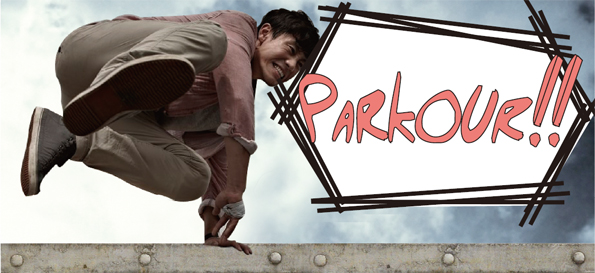
People wearing sportswear are running in an open space in a city. Are they just running? They are jumping over walls, crawling up walls and flying through the air using only their body without equipment. They don’t avoid obstacles that are in front of their eyes, but they jump over these obstacles! This is parkour, which appeared in the film ‘Yamakasi’. -Ed.

■ Parkour, Free running and Yamakasi
Parkour is a modern martial art that began in France in the 1920’s. It originated from the military training ‘Parcours’ in France in World War I, and David Belle developed it after World War I. It signifies the art of displacement which helps the quick and efficient overcoming of various obstacles that exist in nature and cities.
Free running, which started in France, is modified parkour. English speakers used the name ‘Free running’ to refer to parkour as it became known in London, England. It developed into an urban performance art combined with B-boy, acrobatics and gymnastics. The difference between free running and parkour is that free running puts freedom of activities first, but parkour puts efficiency and speed first.
■ Let’s get to know about parkour well!
Although some people are familiar with parkour, many of them misunderstand it. Basically, they are wrong about the name. As the first parkour club in Korea, ‘Yamakasi Korea’ spread parkour with the wrong name, Yamakasi, in mass media. Yamakasi is not a name of an exercise, but it is the team name that David Belle, the founder of parkour, made with 9 friends. The formal name is parkour or free running, not yamakasi.
Also, parkour is not one of the extreme sports. According to an encyclopedia, most sports signify physical activity to compete with others while following the game rules. However, parkour doesn’t have a competition because trainees could suffer serious injuries and do reckless challenges which overstep their limits. Plus, because it doesn’t have an official organization, they don’t establish rules of exercise but pursue their own movement. Following this, parkour is not one of the extreme sports but a discipline like yoga. Therefore, trainees build up healthy bodies and overcome mental fear through parkour.
■ Where, How?
Parkour is self-training, and it can be done anywhere without regard for places like apartment complexes, playgrounds, parks, schools and mountains. The five basic skills of parkour are landing, vaulting, jumping, climbing and hanging. For safety, stretching should precede the practice of parkour skills. Beginners should start with weight training and basic disciplines, like safe ways of falling down so that they can avoid injuries. Parkour doesn’t need any particular devices or instruments, but shoes are important. Running shoes are preferred because normal shoes are slippery.
There are lessons for the beginners who want to learn parkour. They can take lessons from coaches, who received a Certificate of International Parkour Coach(ADAPT), according to weekly schedules in Yonsei University in Seoul, Sajik Sport Complex in Pusan and Yatap Central Library in Seongnam. These lessons consist of stretching, basic disciplines and skills. The schedule can be found in the Naver cafe Korea Free Running & Parkour Federation. Korea Free Running & Parkour Federation(KFPF) was established by gathering teams from all parts of the country in 2006. The number of members in the cafe is about 26,000. Practically, the number of people who do parkour is about 3,000. 95% of them are teenagers. Also, there are meetings in North Chungcheong Province. If you want to practice together, the representative team ‘Team Burst’ is nearby.
■ Feel Free, Fun, Full of confidence
Kang Woo-jae(Female, 17) is a beginner of parkour. She had been acquainted with parkour from her textbook at school and had an interest in it. Through her acquaintance, she joined the club. She said that parkour is fun and disagreed with the prejudice that it would be hard for women to do. “It is really good to do things that I couldn’t do before. Also, I feel free when I hurdle obstacles,” she said.
Kim Ji-ho(Male, 26) is a representative of KFPF. He said that the biggest change after he had started parkour was his fundamental mindset, which had been dispirited before he learned parkour. However, he acquired confidence through parkour. He said that when he was in front of obstacles, he knew himself by feeling fear. “After I knew whether I could do certain disciplines or not, I found my dream,” he said.
Lastly, he said, “Parkour is a discipline for everyone. There are many people who think it is dangerous. Danger is reality, but fear is imagination that people made. Therefore, we can control danger realistically. Fear is a mental obstacle. In the philosophy of parkour, there is a sentence, ‘The persistence of presence’. It means that spirit and body should always coincide. When the body is more predominant than the spirit, there is no development beyond a limit because of fear. On the other hand, when the spirit is more predominant than the body, it causes reckless attempts and danger because the body is not prepared. Therefore, we should balance the spirit and the body and develop ourselves gradually through parkour.”
By Kang Hye-minㅣhm34@cbnu.ac.kr
By Kyeong So-hyeonㅣsh34@cbnu.ac.kr


 All
All Culture
Culture






 Kang Hye-min & Kyeong So-hyeon
Kang Hye-min & Kyeong So-hyeon











